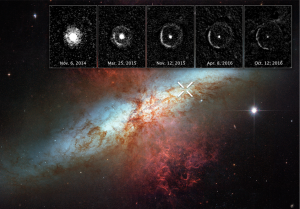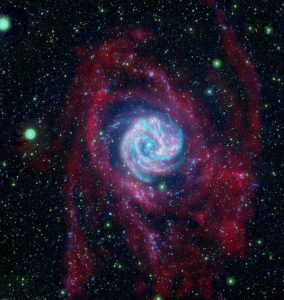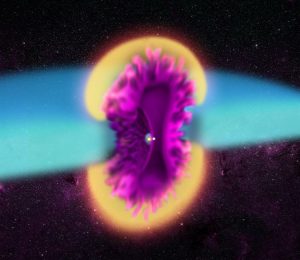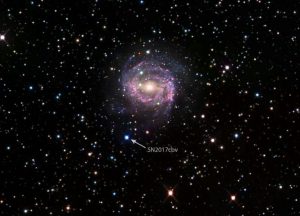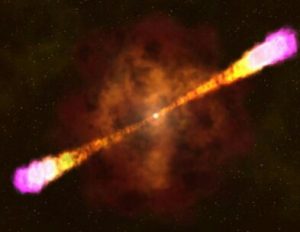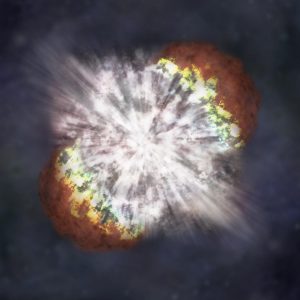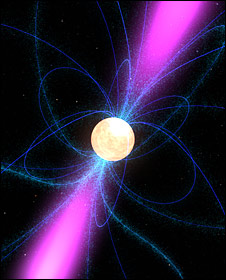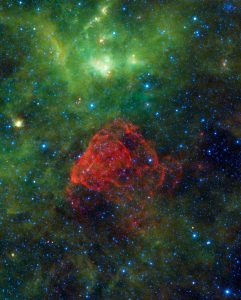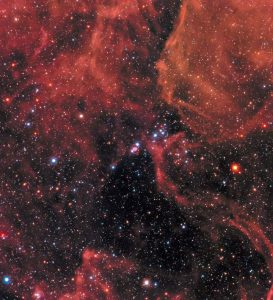esplosione stellare
L’Eco di Luce di una Stella Esplosa
Il telescopio Hubble ha catturato l’eco di luce emessa in seguito alla morte di una stella esplosa nella galassia starburst M82, localizzata a circa 11,4 milioni di anni luce dalla Terra. Continua a leggere
Massicci buchi neri stellari annidati ai confini delle spirali
Le zone periferiche delle galassie a spirale come la nostra potrebbero essere piene di buchi neri in collisione di proporzioni massicce e potrebbero costituire una regione galattica di rilievo in cui andare a cercare sorgenti di onde gravitazionali, secondo uno studio di ricercatori del Rochester Institute of Technology, in via di pubblicazione su Astrophysical Journal Letters. Continua a leggere
V745 Sco: Due Stelle, Tre Dimensioni e Un Botto d’Energia
Un team di scienziati ha analizzato il comportamento della nota stella doppia, V745 Sco, localizzata a circa 25.000 anni luce dalla Terra e caratterizzata da potenti eruzioni individuate fin dal 1937, realizzando un modello tridimensionale dell’esplosione. Continua a leggere
Una Supernova Colta in Flagrante
Per la prima volta gli astronomi hanno osservato in dettaglio un evento cosmico estremo: una supernova e i suoi resti esplosivi che impattano su una stella compagna. Continua a leggere
Studio senza precedenti di un lampo di raggi gamma
Utilizzando telescopi terrestri e spaziali, un team internazionale di astronomi guidato dall’University of Maryland ha ricostruito una delle più dettagliate descrizioni di un gamma-ray burst (gamma-ray burst, GRB) mai realizzate. Continua a leggere
Una Rara, Antica Supernova Superluminosa
La morte di una stella massiccia, avvenuta in una galassia ben dieci miliardi di anni fa, ha creato una rara supernova superluminosa, che gli astronomi ritengono una delle più distanti mai scoperte. Continua a leggere
Dalla Morte di una stella nascono pianeti
Un team di astronomi potrebbe avere svelato un mistero di lunga data relativo alla formazione di pianeti dai resti di un’esplosione di una supernova. Continua a leggere
Un’Antica Supernova
Circa 3700 anni fa gli abitanti della Terra potrebbero avere visto una nuova stella brillare in cielo. Quando si è affievolita ed è scomparsa dalla vista, probabilmente è stata dimenticata, finché i moderni astronomi non hanno trovato i suoi resti, chiamati Puppis A. Continua a leggere
Esplosione Cosmica dal Passato
Tre decenni fa la luce di una titanica esplosione dovuta alla morte di una stella ha raggiunto la Terra. SN 1987A è stata la supernova più vicina osservata dal nostro pianeta sin dall’invenzione del telescopio ed è diventata di gran lunga la più studiata di tutti i tempi, rivoluzionando la nostra comprensione della morte esplosiva delle stelle massicce. Continua a leggere
La Nebulosa del Granchio
Questa immagine mozzafiato del telescopio Hubble ci regala una visione sorprendente dell’intera Nebulosa del Granchio. Il granchio è probabilmente uno degli oggetti più interessanti e più studiati nella storia dell’astronomia, una delle strutture più complesse e altamente dinamiche mai osservate.
